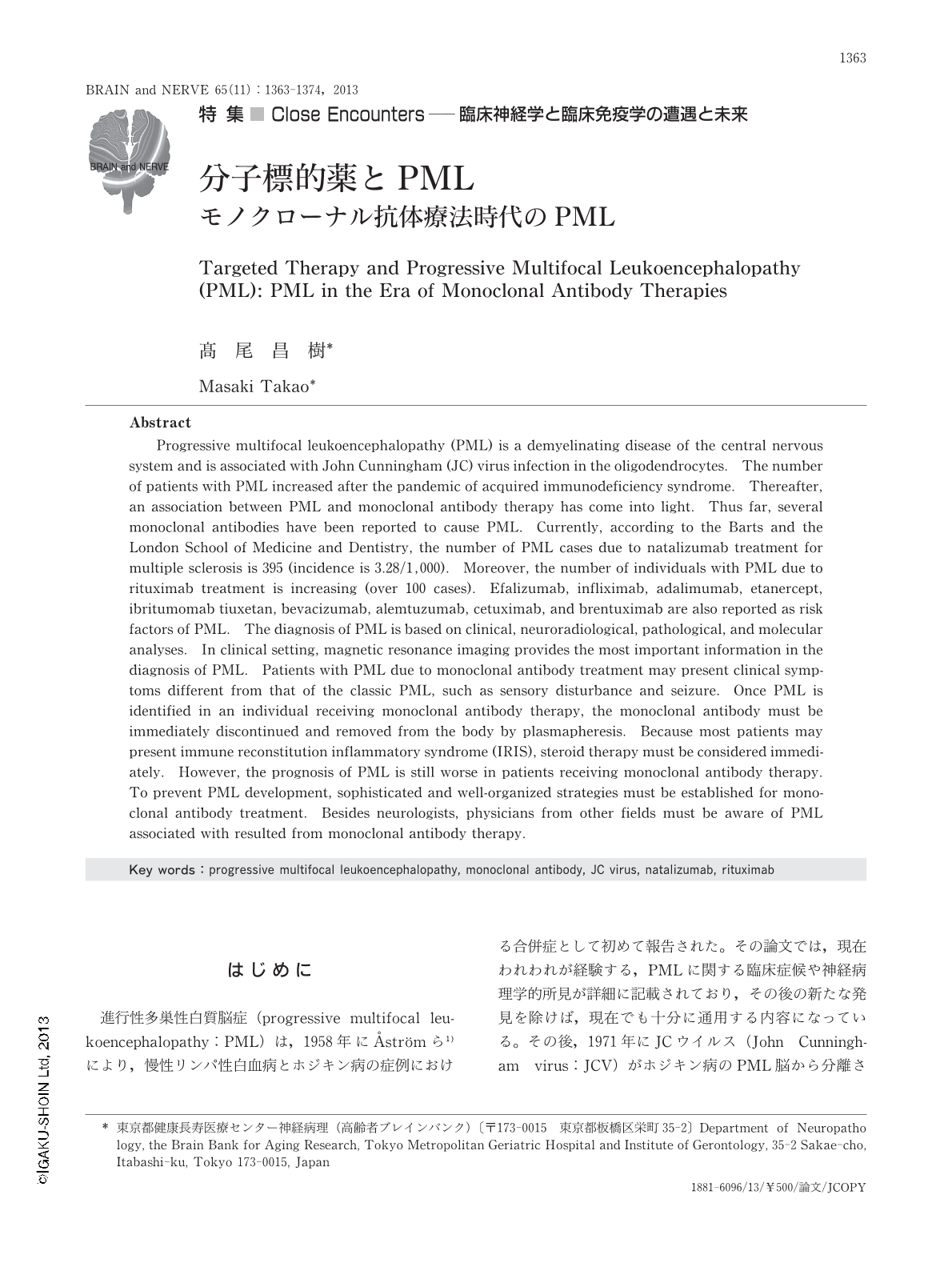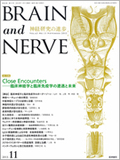Japanese
English
- 有料閲覧
- Abstract 文献概要
- 1ページ目 Look Inside
- 参考文献 Reference
はじめに
進行性多巣性白質脳症(progressive multifocal leukoencephalopathy:PML)は,1958年にÅströmら1)により,慢性リンパ性白血病とホジキン病の症例における合併症として初めて報告された。その論文では,現在われわれが経験する,PMLに関する臨床症候や神経病理学的所見が詳細に記載されており,その後の新たな発見を除けば,現在でも十分に通用する内容になっている。その後,1971年にJCウイルス(John Cunningham virus:JCV)がホジキン病のPML脳から分離され2),PMLの原因がウイルスによる感染性疾患であることが明らかになった。
近年,分子標的治療が主に癌を中心として行われるようになっている。分子標的治療とは,元来は癌細胞だけに作用し,正常な細胞には作用しないような薬物により癌細胞を標的として治療を行うものである。また,癌細胞の成長や転移に関与する,ある種の酵素,蛋白,あるいは何らかの物質といったものに対して作用する治療も含まれる。多くの分子標的治療は,低分子物質かモノクローナル抗体によるものに大別される。特にその中でも,関節リウマチなどの自己免疫性疾患や,多発性硬化症などに対しても,有効性の高いモノクローナル抗体による抗体療法が行われるようになってきた。一方,治療症例数の増加に伴い,さまざまな合併症も報告されるようになってきた。中でも,多発性硬化症に対して米国・欧州で承認され,使用されているナタリズマブによるPMLの発症と,その症例数が増加していることはよく知られている3-5)。
本号の特集では,筋炎や血管炎などの内容が多く,本項の内容はやや異なるものであるため,まずPMLに関して概要を述べた後に,主にモノクローナル抗体療法と関連するPMLに焦点を絞って,現在までの状況など,文献的検討を中心に解説する。PML自体に関する内容の詳細と,AIDSに伴うPMLに関しては,本特集を理解するための範囲にとどめるので,詳細は専門書や文献などを参照されたい。
Abstract
Progressive multifocal leukoencephalopathy (PML) is a demyelinating disease of the central nervous system and is associated with John Cunningham (JC) virus infection in the oligodendrocytes. The number of patients with PML increased after the pandemic of acquired immunodeficiency syndrome. Thereafter, an association between PML and monoclonal antibody therapy has come into light. Thus far, several monoclonal antibodies have been reported to cause PML. Currently, according to the Barts and the London School of Medicine and Dentistry, the number of PML cases due to natalizumab treatment for multiple sclerosis is 395 (incidence is 3.28/1,000). Moreover, the number of individuals with PML due to rituximab treatment is increasing (over 100 cases). Efalizumab, infliximab, adalimumab, etanercept, ibritumomab tiuxetan, bevacizumab, alemtuzumab, cetuximab, and brentuximab are also reported as risk factors of PML. The diagnosis of PML is based on clinical, neuroradiological, pathological, and molecular analyses. In clinical setting, magnetic resonance imaging provides the most important information in the diagnosis of PML. Patients with PML due to monoclonal antibody treatment may present clinical symptoms different from that of the classic PML, such as sensory disturbance and seizure. Once PML is identified in an individual receiving monoclonal antibody therapy, the monoclonal antibody must be immediately discontinued and removed from the body by plasmapheresis. Because most patients may present immune reconstitution inflammatory syndrome (IRIS), steroid therapy must be considered immediately. However, the prognosis of PML is still worse in patients receiving monoclonal antibody therapy. To prevent PML development, sophisticated and well-organized strategies must be established for monoclonal antibody treatment. Besides neurologists, physicians from other fields must be aware of PML associated with resulted from monoclonal antibody therapy.

Copyright © 2013, Igaku-Shoin Ltd. All rights reserved.


